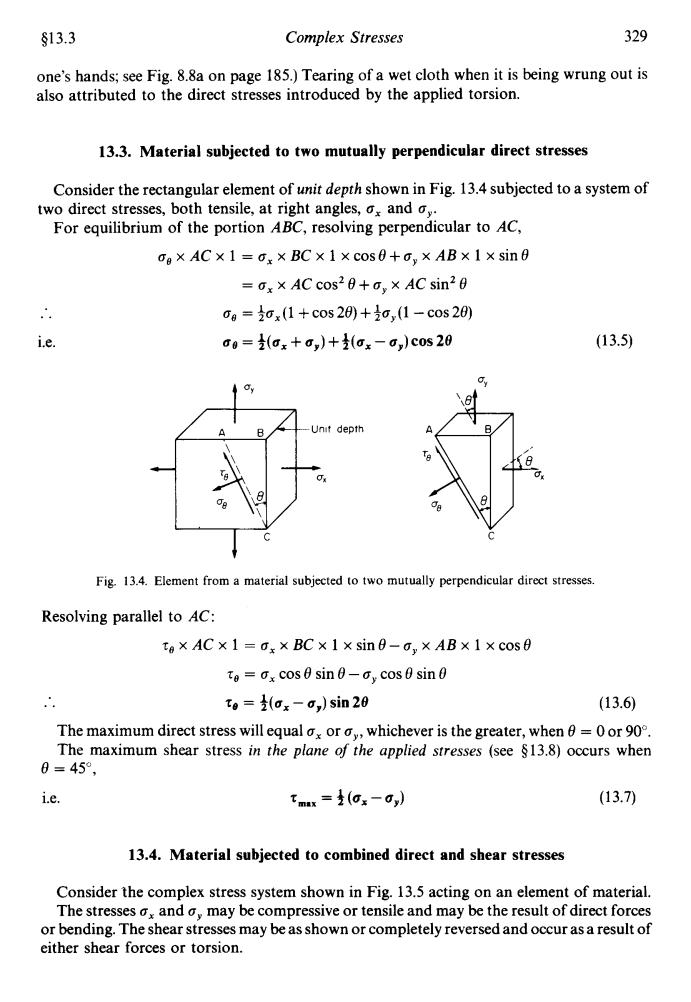正在加载图片...

§13.3 Complex Stresses 329 one's hands;see Fig.8.8a on page 185.)Tearing of a wet cloth when it is being wrung out is also attributed to the direct stresses introduced by the applied torsion. 13.3.Material subjected to two mutually perpendicular direct stresses Consider the rectangular element of unit depth shown in Fig.13.4 subjected to a system of two direct stresses,both tensile,at right angles,ox and o,. For equilibrium of the portion ABC,resolving perpendicular to AC, og×AC×1=ox×BC×1×cos0+o,×AB×1×sin0 =ox×AC cos29+o,×AC sin20 0g=ox(1+cos20+o,(1-cos20) i.e. 00=(ax+0,)+(ox-c,)c0s20 (13.5) 6 Unit depth Fig.13.4.Element from a material subjected to two mutually perpendicular direct stresses. Resolving parallel to AC: ta×AC×1=ox×BC×1×sin8-o,×AB×1Xcos0 te=x cos sin0-ay cos 0 sin0 tg=(ox-o,)sin20 (13.6) The maximum direct stress will equal ox or whichever is the greater,when=0or 90. The maximum shear stress in the plane of the applied stresses (see $13.8)occurs when 0=45°, i.e. tmx=是(ox-0,) (13.7) 13.4.Material subjected to combined direct and shear stresses Consider the complex stress system shown in Fig.13.5 acting on an element of material. The stresses and may be compressive or tensile and may be the result of direct forces or bending.The shear stresses may be as shown or completely reversed and occur as a result of either shear forces or torsion.$13.3 Complex Stresses 329 one's hands; see Fig. 8.8a on page 185.) Tearing of a wet cloth when it is being wrung out is also attributed to the direct stresses introduced by the applied torsion. 13.3. Material subjected to two mutually perpendicular direct stresses Consider the rectangular element of unit depth shown in Fig. 13.4 subjected to a system of For equilibrium of the portion ABC, resolving perpendicular to AC, two direct stresses, both tensile, at right angles, ax and ay. box ACx 1 = a, x BC x 1 xcos8+oY x ABx 1 x sin8 = a, x AC cos' 8 +ay x AC sin'8 .. = +ox (1 + COS 28) + icy (1 - cos 28) i.e. ug = ~(ux+uy)+~(ux-ubg)c~~2e (1 3.5) t i Fig. 13.4. Element from a material subjected to two mutually perpendicular direct stresses. Resolving parallel to AC: zo x AC x 1 = a, x BC x 1 x sine-a, x AB x 1 x cos8 .. zo = a, cos 8 sin 8 - ay cos 8 sin 8 re = $(ux - uy) sin 28 (13.6) The maximum direct stress will equal a, or by, whichever is the greater, when 8 = 0 or 90". The maximum shear stress in the plane of the applied stresses (see $13.8) occurs when e = 450, i.e. rm.x = 4 (ax - by) (13.7) 13.4. Material subjected to combined direct and shear stresses Consider the complex stress system shown in Fig. 13.5 acting on an element of material. The stresses a, and ay may be compressive or tensile and may be the result of direct forces or bending. The shear stresses may be as shown or completely reversed and occur as a result of either shear forces or torsion